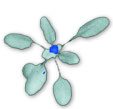|
The Arabidopsis CaM and CaM-like (CML) family
Calcium acts as a second messenger in plant cells in response to diverse biotic and abiotic stimuli. The task of interpreting complicated calcium signals falls in part to calmodulin (CaM) and CaM-like (CML) proteins. CaM has four calcium binding sites and experiences a calcium-induced conformational change that facilitates its interaction with downstream effector proteins. Different affinities for calcium and for downstream targets allow the potential for this family to interpret the messages encoded by calcium fluxes involved in many cellular processes. We would like to understand the role this family plays in decoding calcium signals. We are pursuing mutants in each of the genes and examining their expression patterns in response to developmental and environmental stimuli.
Using the Arabidopsis databases, we identified and classified CAM and CML genes (McCormack and Braam, 2003 PDF ). Arabidopsis has 7 typical CAMs: CAM1 and CAM4 encode identical protein products; CAM2, CAM3 and CAM5 encode a second Arabidopsis CaM isoform, differing from the CaM1/CaM4 isoform by 5 amino acids; CaM7 differs from the CaM1/CaM4 isoform by four amino acids; CaM2/CaM3/CaM5 and CaM6 differ from CaM7 by only a single amino acid. Arabidopsis CaMs, therefore, show a similar conservation of sequence that is seen in vertebrates; vertebrates also have 3 CAM genes, like the CAM2, CAM3 and CAM5 genes, that encode identical CaM proteins. Link to CaM alignments.
The 50 CaM-like (CML) proteins have the following characteristics: presence of EF hand motifs important for binding calcium (predicted, based on sequence, to be functional), no other identifiable functional domains, and at least 16% overall amino acid identity with CaM. Sequence comparisons separate the CaM and CML family members into 5 groups based on relatedness to the typical CaMs (McCormack and Braam, 2003 PDF).
Most of the CML proteins under study have 4 predicted EF hands; only 1, CML12 (also known as TCH3), has more than 4 hands. The proteins are relatively small, ranging from 83 to 330 amino acids. Only the 8 proteins most closely related to typical CaM contain a Cys residue in the first EF hand, an unusual characteristic of plant CaMs. Many of the proteins (26/51) have the conserved Lys, corresponding to Lys115 of CaM, which is a site for trimethylation. Most of the CML proteins are Met-rich. Whereas, the average Met content of proteins is ~1.5%, the 7 CaMs have ~6% Met. Some of the proteins have at least weak consensus sites for myrisoytlation sites; none have predicted N-terminal signal peptides.
The family members are distributed on the 5 chromosomes. There are 5 tandemly arranged gene pairs.
Intron/exon organization has also been determined.
Table 1: Characteristics of CaM/CML Proteins
Table 2: Characteristics of CAM/CML Genes.
Phylogenetic Tree
CAM and CML Gene Expression
Expression analyses provide strong evidence of subfunctionalization, as reviewed in McCormack, Tsai and Braam, Trends in Plant Sciences, 2005 (published early on line PDF).
Genevestigator (website link; Zimmerman et al., 2004 PDF ):
Links to:
Developmental Stage Expression
Organ-Specific Expression
Stimulus-Induced Expression
MPSS data for CAMs and CMLs. (website link; Meyers et al., 2004 PDF ):
CAM and CML Expression inducible by touch and/or darkness (from Lee et al., New Phytologist, 2005)
|





